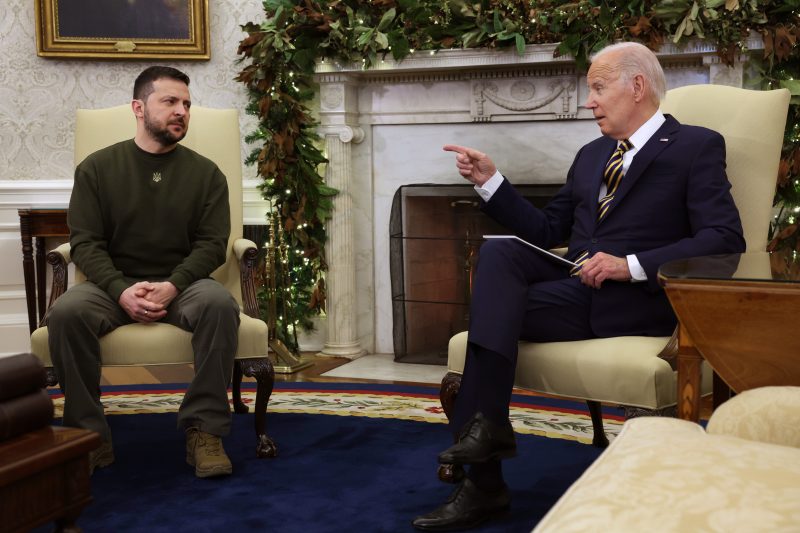Volodymyr Zelensky was elected president of Ukraine on April 21, 2019. He defeated incumbent president Petro Poroshenko by a wide margin, a function both of questions about Poroshenko’s ethics and Zelensky’s popularity as an actor on television.
That same day, Zelensky took a congratulatory call from the president of the United States. His desired outcome was obvious, asking his U.S. counterpart multiple times to attend his upcoming inauguration.
“We in Ukraine are an independent country and independent Ukraine,” Zelensky said — an unsubtle reminder of the existing conflict with Russia. If the American leader could be there, it would be “a great, great thing for you to do,” a physical manifestation of the U.S.’s commitment to Ukrainian independence.
President Donald Trump didn’t attend the 2019 inauguration. Neither did Vice President Mike Pence, who’d originally been slated to. The impeachment investigation that began a few months later revealed that Pence’s attendance was spiked after an aide to Trump’s attorney Rudy Giuliani allegedly told the Ukrainians that the vice president’s attendance was contingent upon Zelensky announcing an investigation into Joe Biden, Trump’s presumed and eventual opponent for reelection.
That investigation stemmed from Zelensky’s second call with Trump. By that point — July 2019, two months into Zelensky’s term in office — the Ukrainians were pushing for a different demonstration of American unity: a meeting at the White House.
“I am very hopeful for a future meeting,” Zelensky said in that call. The impeachment inquiry revealed that such a meeting was contingent upon an announcement of a Biden investigation, as transmitted to Zelensky’s team by a Trump appointee.
“I also wanted to thank you for your invitation to visit the United States, specifically Washington, D.C.,” Zelensky told Trump. “On the other hand, I also wanted [to] ensure you that we will be very serious about the case and will work on the investigation.”
“Whenever you would like to come to the White House,” Trump said a bit later, “feel free to call.” It was his first mention of a direct invitation.
Behind the scenes, Trump and his allies continued to pressure Zelensky for an announced investigation. The supposed predicate, you’ll recall, was that Biden’s son Hunter worked as an adviser to a Ukrainian energy company called Burisma. When Biden, then serving as vice president, joined other international leaders in 2015 in calling for the ouster of a prosecutor accused of corruption, the prosecutor alleged that he’d been targeted by Biden because he’d been about to expose corruption at Burisma. There’s no evidence this was the case, but for Trump, elevating the idea that it might be promised to reap political rewards. With no announcement from Zelensky, the Trump administration halted planned military aid for Ukraine — until a whistleblower drew attention to the effort to leverage governmental power to benefit Trump’s reelection.
All of this came to a head in September 2019, just as Zelensky and Trump met for the first time on the sidelines of the United Nations’ general assembly in New York.
Between the time that Zelensky won his election and Trump was impeached, the American president hosted more than a dozen other foreign leaders at the White House.
On Wednesday, Zelensky is getting that meeting — in a very different context and with a very different American president. The Ukrainian left his home country in secret, making his way by train to Poland, where a U.S. military aircraft flew him to Washington. The need for the secrecy is obvious. Since Russia expanded its invasion of Ukraine earlier this year, Zelensky’s been a prime target. His trip to the United States is intended to bolster America’s commitment to supporting Ukraine’s defense — and once again, to send a signal to Russia about the strength of the U.S.-Ukrainian alliance.
It’s also, in part, probably meant to put pressure on Republican legislators who’ve been using aid to Ukraine as a point of attack against the Biden administration. The far right has expressed more open sympathy with Russia since the conflict escalated, with politicians such as Rep. Marjorie Taylor Greene (R-Ga.) disparaging the Ukrainian president and criticizing the scale of American aid. That latter complaint has gained some traction; Zelensky’s visit is clearly meant to increase its political cost.
Zelensky’s been to the White House once before — in September 2021, two years after his grim encounter with Trump in New York. That meeting was very different, however, with Zelensky in a suit and tie, and much of the attention centered on his interactions with Biden’s predecessor. Russia would soon after begin to circle Ukraine with troops and military vehicles.
The current trip is a better reflection of the way in which motives and intended outcomes have and haven’t changed since 2019. Then, Zelensky wanted a demonstration of American support — something manifested clearly in the wake of Russia’s expanded attack on his country. Now, he wants an international demonstration that the support is ongoing — and even expanding.
For his part, Biden wants to demonstrate the solidity of the relationship in part as a way of keeping Russia, and President Vladimir Putin, in check. The U.S.-Ukraine partnership has led to humiliating losses for the Russians. What Putin apparently expected to be a rapid capitulation has, instead, been a 300-day conflict in which Russia has made little progress. Biden, who has made the fight between democracy and autocracy a central part of his presidency, is eager to demonstrate America’s strength, even if only indirectly.
And then there was Trump. That the U.S. had committed support for Ukraine was secondary to his own desire to boost his reelection bid. His motivation was personal, not national. Zelensky’s wish to show how the U.S. and Ukraine were allied was simply a point of pressure Trump could put to his own uses.
But Zelensky’s presidency outlasted Trump’s. The new American administration has been the partner that Zelensky always wanted.

